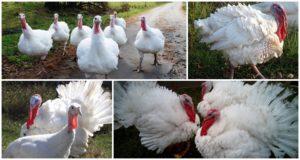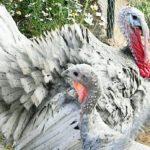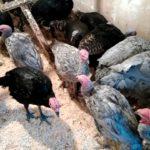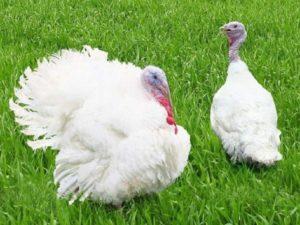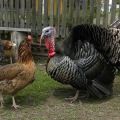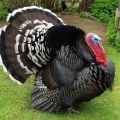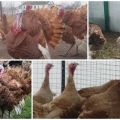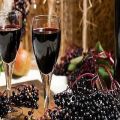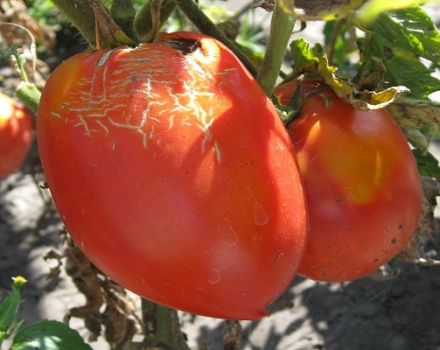Description of blue slate turkeys and characteristics of the breed, breeding
Blue turkeys are an interesting and distinctive breed. They are often called slate. These birds were bred relatively recently. Most often they are bred for decorative purposes. Therefore, such birds are rarely found on farms. To succeed in raising these birds, they need to provide complete and quality care. A balanced diet is also important.
Origin
This breed was bred by American breeders, and it happened by accident. Scientists conducted research on 2 genotypes of birds with black and white feathers. As a result, the chicks had an ashy shade of plumage. Slate asp has a similar color. The stones come in different shades - from black to blue-gray. Therefore, turkeys with blue feathers are often called slate.
The breed was described in 1874. It was then that the bird was introduced to the public. It has been recognized by the American Poultry Association and the European Community. Officially, the birds were called blue, lavender or blue slate.
Unfortunately, the economic crisis has led to few farmers choosing to breed birds with colorful feathers. Entrepreneurs relied on obtaining eggs and meat, rather than decorative poultry farming.
Therefore, slate turkeys were undeservedly forgotten. Today, the number of these animals is small. Birds are mainly found in zoos or in small private farms in which the purity of the breed is monitored.
Characteristics and description of the breed
A detailed description of the birds is recorded in the documentation of the American Quality Standard. It provides information on all types of turkeys that are bred in Europe and the United States.

For blue turkeys, the following properties are characteristic:
- Feathered have blue, lavender, or ash blue feathers. Such individuals are able to take part in competitions. Sometimes birds are distinguished by black or white accents in combination with a blue background.
- Birds have a small head. Moreover, there is a rare fluff on the skin. The cover is distinguished by color shades - white, blue, red. There is a pink horn on the head. The eyes are brown and the beak is light.
- The neck is not covered with feathers. There are bright red folds in this area. They form corals.
- Metatarsus are covered with pink scales.
- The feathers are thick and lush. They make the torso look larger. The back and chest are blue. Moreover, it is lighter on the belly and tail. The tail feathers often contain light or dark elements.
- Females weigh 6.3 kilograms, males 10.5.Individuals belong to the light cross.
- Sexual maturity in these birds occurs at 8-9 months.
- To get offspring, families are created from young birds. Moreover, there should be a maximum of 8 females per 1 male.
- The eggs are covered with a creamy shell. Moreover, their weight is 75 grams.
- The incubation period is 28-30 days.
- Turkey poults are distinguished by gray feathers. Their weight is 50 grams. Cubs are characterized by rapid weight gain.
- The productive mass of birds increases by 8 months.
American farmers argue that birds are considered very undemanding to keeping conditions. This type of turkey is characterized by a high degree of resistance to the influence of stress factors. They show little or no aggression. Emotionality is more characteristic of males. At the same time, they demonstrate aggression or anxiety only in case of approaching danger.
Blue turkey meat has excellent taste, but the carcass does not always look attractive as it is covered with gray skin.
Pros and cons of blue turkeys
At the same time, blue turkeys also have certain disadvantages. They are considered very picky about the conditions of detention and need a balanced diet.
How to properly maintain and care for a bird
Slapy turkeys withstand the cold with ease. However, they feel much better in warmth. It is important that the house is dry. Therefore, moisture should not be allowed to enter the turkey housing. It is worth placing a litter on the floor, which is recommended to be systematically changed.
Observing the chicks that have just hatched is also important. On the first day, they should be warm and dry. For this purpose, it is permissible to use a cardboard box. The temperature regime in the box should be +36 degrees.
It is recommended to equip the room for slate turkeys in accordance with certain rules. It is permissible to place a maximum of 2 individuals on 1 square meter of area. Temperature conditions are of great importance. In winter, it should be at least +5 degrees, in summer - +20.

Drawing up a diet
Blue turkeys need a balanced menu. It is best to buy special food for them. However, if necessary, it is permissible to feed the birds with cereals, grass and certain types of vegetables. In spring and summer, turkeys are worth walking. This will help them find food for themselves.
Breeding rules
To get blue turkeys, you have to buy a parent flock. It is not worth purchasing fertilized eggs, since it is not always possible to obtain the desired result. Females of this breed are characterized by a pronounced maternal instinct. The hen is capable of incubating 20 eggs. However, most often they put no more than 17.
Diseases of slate turkeys
Blue turkeys often get sick from contact with other animals. They suffer from such pathologies:
- respiratory mycoplasmosis - associated with high humidity in the house;
- tuberculosis - is considered a dangerous pathology that spreads through contaminated feed and water;
- histomoniasis - accompanied by weakness and loss of appetite and is due to insufficient quality disinfection of the room.
Blue turkeys are distinguished by an interesting feather color. They have many advantages, but they need special conditions of detention. For birds to grow successfully, they need quality care.
